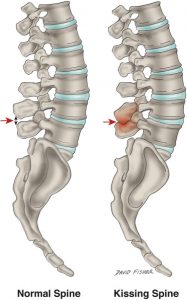Kissing Spine (Baastrup Syndrome)
Colgan Osteopathy in Kettering
Baastrup Syndrome (Kissing Spine)
Also known as Baastrup’s sign, Baastrup’s disease, or interspinous bursitis. This syndrome was first diagnosed by Baastrup in 1933. Baastrup Syndrome or Kissing Spine Syndrome is a relatively common medical condition of the vertebral column where the spinous processes of the two adjacent vertebrae come in contact with each other resulting in back pain. This is most common in the lumbar spine but in rare cases, this is known to occur in the cervical spine also. Baastrup’s syndrome is often misdiagnosed and consequently treated incorrectly.

Causes of Baastrup Syndrome (Kissing Spine Syndrome)
The cause of the back pain resulting from Baastrup Syndrome or Kissing Spine Syndrome is mainly mechanical as a result of the adjacent spinous processes coming in contact with each other.
Suggested risk factors are:
- Excessive lordosis which results in increased mechanical pressure
- Abdominal Obesity
- Repetitive strains of the interspinous ligament with subsequent degeneration and collapse
- Incorrect posture
- Traumatic injuries
- Stiffening of the thoracic spine or the thoracolumbar transition
Symptoms of Baastrup Syndrome (Kissing Spine Syndrome)
Patients with Baastrup syndrome typically show excessive lordosis. When describing the symptoms of Baastrup Syndrome or Kissing Spine Syndrome, the patient will describe spinous process pain, which may or may not be referred. The L4-L5 level is generally the area which is mostly affected. Patients with Kissing Spine often complain about back pain, more specifically, midline pain that radiates distally and proximally, increasing on extension and reducing on flexion. Other characteristics can be pain upon palpation at the level of pathologic interspinous ligament, oedema, cystic lesions, sclerosis, flattening and enlargement of the articulating surfaces and bursitis.
Diagnosis of Baastrup Syndrome (Kissing Spine Syndrome)
Your doctor may start your evaluation by performing a physical exam. In addition to gathering your medical history and reviewing your symptoms, he or she may ask you to perform physical manoeuvres to recreate the pain you’ve described. Because the pain of Baastrup’s syndrome is aggravated by extension and eased by flexion, your doctor may ask you to arch and round your back to determine how those movements influence your pain levels.
Your doctor will not be able to confirm a kissing spine diagnosis on a physical exam alone—he or she will also need to order imaging scans. Several imaging tests may be used, including x-ray, computed tomography (CT), and magnetic resonance imaging (MRI).
X-ray may show the spinous processes making contact, but CT scans will better illuminate degenerative changes (eg, a herniated disc) caused by the disorder. However, MRI is best suited to highlight areas of degeneration involving the soft tissues of the spine and can detect kissing spine in its earliest onset. Your doctor may order a combination of imaging scans to get a complete picture of the affected area.
Treatment for Baastrup Syndrome (Kissing Spine Syndrome in Humans)
Treating the hyperlordosis is a key aspect, hence strengthening of the trunk muscles is recommended, along with postural education and hip flexor stretches. Furthermore, the rectus femoris muscle is a continuation of the hip flexor complex so it is important to stretch these muscles. The hip flexors can become shorter through long-term sitting or resting.
Colgan Osteopathy in Kettering Northamptonshire
Colgan Osteopathy in Hatfield, Hertfordshire
To book an appointment, call 07738493974 or book online
Please visit our Blogs:
Traditional Chinese Medicine in Kettering

